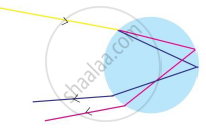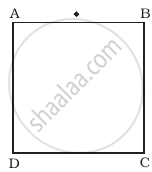Advertisements
Advertisements
प्रश्न
उत्तर
Factors affecting the critical angle are:
(i) The colour (or wavelength) of light.
(ii) The temperature (on changing the temperature of medium, its refractive index changes).
APPEARS IN
संबंधित प्रश्न
Swarali has got the following observations while doing an experiment. Answer her questions with the help of observations.
Swarali observed that the light bent away from the normal, while travelling from dense medium to rarer medium. When Swarali increased the values of angle of incidence (i), the values of angle of refraction (r) went on increasing. But at a certain angle of incidence, the light rays returned into the dense medium.
So, Swarali has some questions. Answer them –
a) Name this certain value of ‘i ’. What is the value of ‘r’ at that time ?
b) Name this process of returning of light in dense medium. Explain the process.
i) Observe the given figure and answer the following questions.
a) Identify and write the natural process shown in the figure.
b) List the phenomena which are observe in this process.
c) Redraw the diagram and show above phenomena in it.

Plot a graph between
Angle of incidence versus angle of reflection,
Plot a graph between
Angle of incidence versus angle of refraction.
A ray of light incident at an angle of incidence ‘i’ passes through an equilateral glass prism such that the refracted ray inside the prism is parallel to its base and emerges from the prism at an angle of emergence ‘e’.
What can you say about the value of the angle of deviation in such a situation?
Name the factors affecting the critical angle for the pair of media.
Answer the following question.
What are the advantages of optical fibre communication over electronic communication?
A green light is incident from the water to the air-water interface at the critical angle `(theta)`. Select the correct statement
The critical angle is defined as the angle of incidence at which the total internal reflection starts to occur.
A rectangular block of glass ABCD has a refractive index 1.6. A pin is placed midway on the face AB (Figure). When observed from the face AD, the pin shall ______.

- appear to be near A.
- appear to be near D.
- appear to be at the centre of AD.
- not be seen at all.
